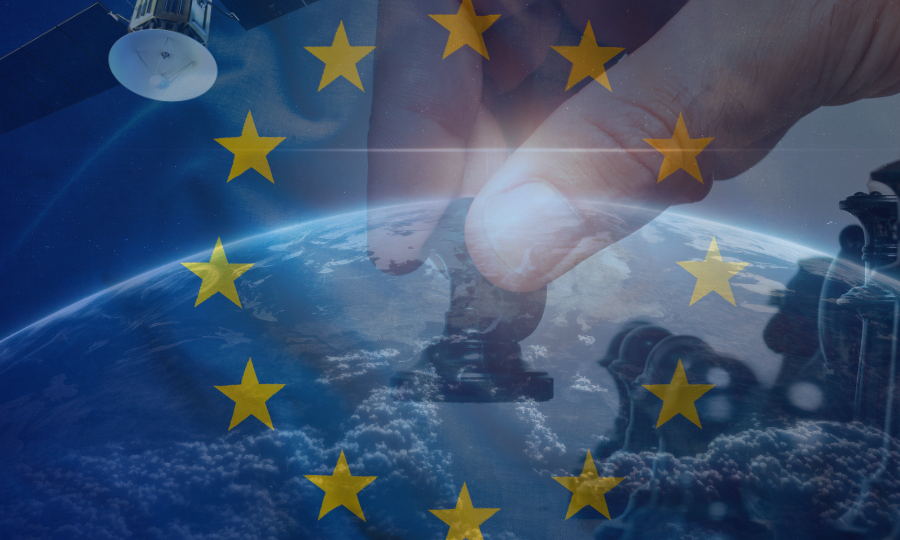Christophe Bosquillon

Recently the European Union (EU) released its EU Space Strategy for Security and Defence. This document is centered on safeguarding space activities and enhancing the security of EU interests and capabilities in space through member-state cooperation. The document rightly recognizes growing threats against space assets, which enable modern civilization and warrant active protection and defense. The policy correctly emphasizes the requirement for capabilities to detect and respond to hostile behaviors in space promptly.
It calls for a coordinated response using all available tools and those of member states. This includes dual-use space systems and services. However, the policy remains confined to an emphasis on resilience of space assets and confidence-building measures to clarify intentions behind various space activities. While this is not a bad thing, it does not express the European Union’s readiness to prevent and respond to space attack by deterring adversaries from hostile actions.
Space Threat Analysis
The EU proposes an annual classified analysis of space threats called the Single Intelligence Analysis Capacity (SIAC), a system of systems where both civilian and military contributions are used for all-sources intelligence assessments. This integrates all space threat analyses within the broader EU threat analysis process. However, its key asset, the EU Satellite Center, requires timely geospatial and orbital intelligence capabilities. It needs to see that long-acknowledged technological shortcomings in early warning and conflict analysis are effectively addressed.
Space Threat Response Architecture
When responding to space threats, the strategy calls for a comprehensive toolbox of joint EU state responses but goes no further in stating what these responses might look like. It does emphasize information-sharing and regular exercises. While the EU considers preventive and restrictive measures under the Common Foreign and Security Policy, it has yet to determine whether to treat attacks in the space domain as armed aggressions under Article 42(7) of the EU Treaty.
The EU rightly acknowledges the need to enhance the use of space for security and defense and intends to do so by integrating the space dimension into Common Security and Defence Policy (CSDP) missions. Strengths include additional communication services through IRIS2 and relying on assured independent access to space. IRIS2 is the new EU secure satellite constellation which stands for Infrastructure for Resilience, Interconnectivity, and Security by Satellite. However, while IRIS² is a credible prospect, European independent access to space remains hindered by bureaucratic processes.
Indigenous Launch Capabilities
The EU made the strategic mistake of not developing any heavy lift reusable launch vehicles and the maiden flight of its expendable heavy lift launcher program, Ariane 6, is delayed until 2024. Even if successful, it will remain expensive and subsidized to survive. This led to contracting SpaceX for launch services for such EU mainstays as the Galileo navigation satellites.
Space Norms of Behavior
On norms for responsible behaviors in space, the EU reaffirms its commitment to norms and joined the US in condemning destructive anti-satellite missile (ASAT) tests. The strategy underscores the priority of dialogue with spacefaring nations and international organizations to ensure norm implementation. While the establishment of a structured dialogue on space norms between the EU, North Atlantic Treaty Organization (NATO), and the United Nations (UN) is a step in the right direction, the strategy falls short in acknowledging that normative cooperation alone will not deter adversary behavior. This is due in part to Russia and China’s opposition for such norms and their rapid buildup in ASAT weapons and other offensive space forces. In short, the EU is posturing for resilience, not deterrence.
Resilience-based Posture
Back to the very core of the EU Space Strategy for Security and Defence, which is to “enhance resilience and protection of space systems,” the document emphasizes the need for a common resilience framework, proposing the creation of an EU Space Information Sharing and Analysis Centre (ISAC). In the realm of defense space systems, EU member states tend to develop indigenous capabilities. The United Kingdom leads with the sixth-generation Skynet for military telecoms, followed by France’s Syracuse, and Italy’s Sicral. Despite attempts at common definitions, a shared system remains elusive. An exception is the joint high-speed communication satellite Athena-Fidus by France and Italy. The EU Commission aims for the GOVSATCOM system, providing secure government communications. Observation satellites for reconnaissance see France pioneering with Helios, while European collaboration efforts falter due to national-centric approaches and protective industrial interests.
Strengthen EU Space Industry
Overall, the intention to reduce European strategic dependencies on foreign-produced critical technologies, while keeping the industrial base for its civilian and defense value chains sovereign and competitive, is a good goal. This will be easier said than done, considering the entanglement of Europe with technologically advanced economies such as the US and Japan. Moreover, challenges stem primarily from economic dependency on China. The solution has been defined as “de-risking” rather than “decoupling.” It is not entirely clear how that might work.
In conclusion, the new EU strategy addresses challenges and outlines goals for strengthening capabilities and cooperation in the space domain. Unfortunately, it fails to address gaps in deterrence measures and consider the evolving geopolitical landscape to ensure the security of EU space systems. While Russia showed some restraint in orbital warfare by relying on non-kinetic and reversible capabilities against Ukrainian and Western space assets, there is no guarantee China would similarly restrain itself. Are the EU and its allies ready for prime time in a major space conflict? The answer to that question might come earlier than we think.
No comments:
Post a Comment